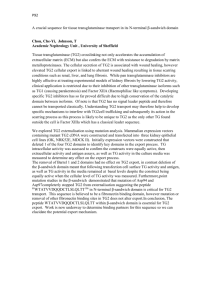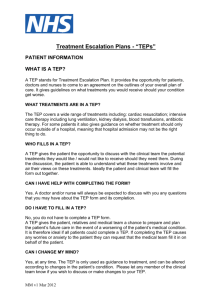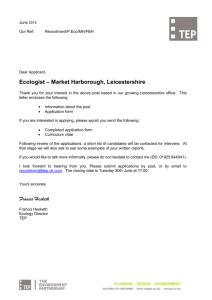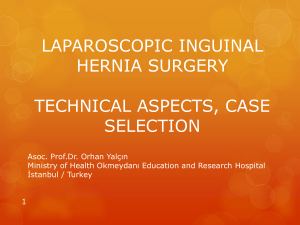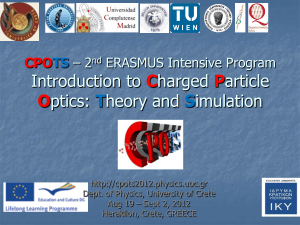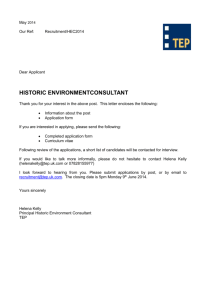ITER tritium fuel cycle modeling
advertisement
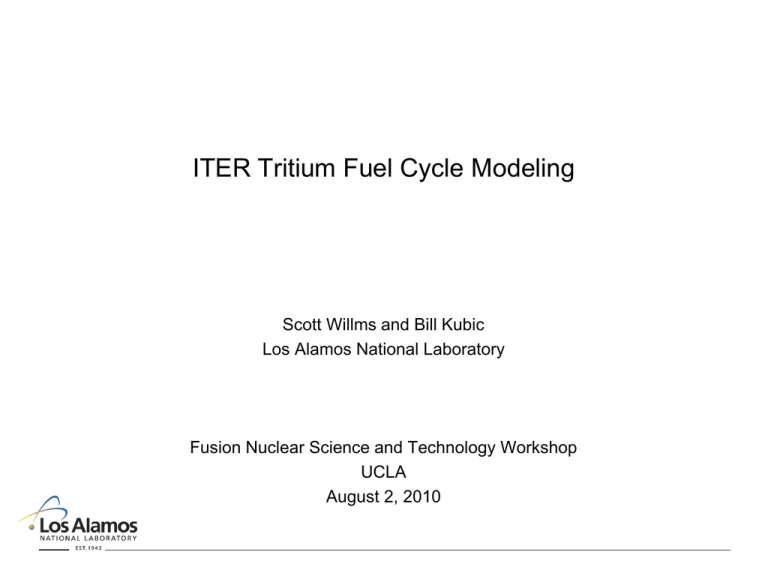
ITER Tritium Fuel Cycle Modeling Scott Willms and Bill Kubic Los Alamos National Laboratory Fusion Nuclear Science and Technology Workshop UCLA August 2, 2010 Outline • Tritium Processing modeling history • TEP modeling • Consideration of next steps 2 Tritium processing modeling history 3 Simplified ITER flow diagram Example fusion fuel cycle modeling efforts Code TBR-related FC model Period Mid 1980’s Code Base Custom Institution(s) UCLA Type of code High-level, first-order differential equations Purpose Estimate required TBR Supercode Late 1980’s Custom ANL, LANL Scaling laws TSTA Model Late 1980’s Custom LANL Algebraic flow and reaction equations Cost and overall size Pressure/flow control Dynsim 1980’s-1990’s Custom LANL-Japan Rigorous ISS CFTSIM 1990’s Custom CFFTP Rigorous ISS TRUFFLES 1990’s Custom UCLA-LANL TRIMO 1990’s-2000’s Custom ITER TEP 2006-2010 Commercial CFFTPUCLA-ITERFZK LANL-SRNL High-level, modular fuel cycle High-level, modular fuel cycle Medium-level, modular systems code ISS understanding and design ISS understanding and design T inventory, FC design T inventory, FC design (ITER) TEP design 5 Uses for tritium processing models • • • • • • • • • • Component design System design Parameter regression Technology trade-off studies Hazard characterization and analysis Requirements determination Control system development Experimental development augmentation Design documentation Operator training 6 ITER TEP modeling 7 TEP process flow diagram TEP modeling overview • TEP model used for: – Component regression from experimental data – Technology selection – Component sizing • TEP models include: – Component models o Detailed understanding of component performance – System models o Overall process performance 9 Modeling tools relationship Aspen property library Kinetic model data Aspen Plus Basic flowsheet data User defined model Steady state model Aspen Dynamics library Aspen Custom Modeler Aspen Dynamics Dynamic model Custom TEP library 10 TEP models completed • Modules – – – – – – – – Permeator (ACM) PMR (ACM) PERMCAT (stand-alone) Vacuum Pumps (ACM) Ambient molecular sieve bed (ACM) Cryogenic molecular sieve bed (ACM) Dynamic feed generator (ACM) Molecular and transition flow conductance model (ACM) • Sub-Systems – Hydrogen-like processing – Air-like processing – Water-like processing 11 Examples of module bechmarks Comparison of permeator model with data of Willms et al. (1993) Comparison the model with LANL data for a Normetex 15 backed by an MB-601 12 Aspen Model of Permeator / AMSB for HLP 13 Aspen Model of Combined ALP-WLP 14 Aspen system models used to optimize design • Can account for system interactions in the design process – Permeator-pump interactions – PMR-pump interactions – Multistage permeator pump performance • Easy to modify PFD to reduce equipment sizes and minimize pumping requirements • Can base sizing calculations on overall system performance 15 Example - Permeator Optimization • Tritium release from third stage as a function of number of first stage pumps – Determine tritium release from third (final) stage peremator – Determine breakthrough area • First stage area as a function of number of first stage pumps Most Common Operations Tritium release from third stage as a function of feed rate Determine number of pumps and permeator area based on point of dimishing returns – Six MB-601 pumps for first stage – 3 m3 of membrane area for first stage • Permeator Train Breakthrough Vary the number of first stage pumps Evaluate system margin – Margin based on overall system performance and not individual units 16 Consideration of next steps 17 DT Major flow paths for ITER Fuel Cycle during DT 18 Next steps • Past modeling efforts have laid an excellent foundation for the next work that needs to be performed • The ITER TEP modeling effort has laid an excellent template for future work • Major development needed includes: – – – – – Models of ITER sub-systems (expect for TEP) ITER Fuel Cycle model ITER TBM modeling Fusion Nuclear Science Facility model Benchmarking 19 Summary • Computer modeling has been an important component of tritium processing development • Recent ITER TEP modeling was not only successful in itself, but lays an excellent template for future modeling work • There are a number of current and future projects which would benefit greatly from further modeling work 20

